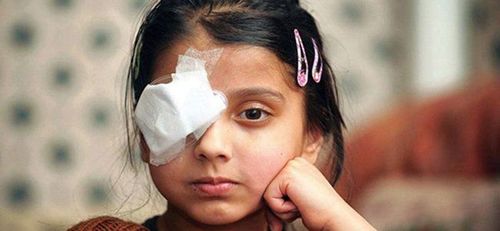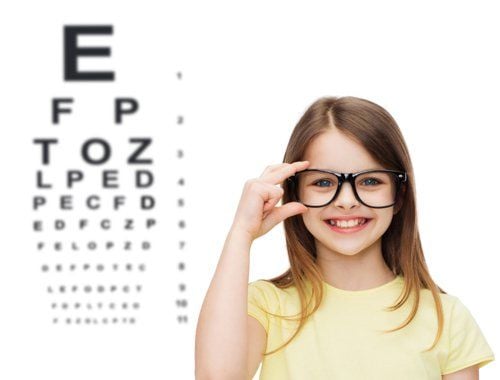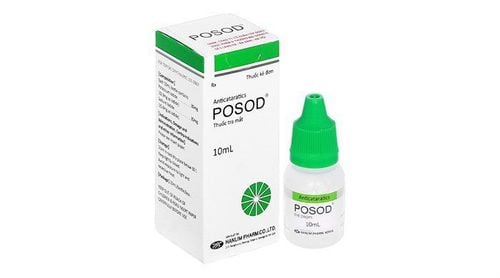This is an automatically translated article.
The article is professionally consulted by Specialist Doctor II Nguyen Thai Hung - Department of Medical Examination & Internal Medicine - Vinmec Danang International General Hospital.
1. When should strabismus surgery?
Strabismus or crossed eyes is a condition where the two pupils are not in a balanced position, one eye looks straight while the other eye can be turned inward, outward, more rarely, it can shift upwards or downwards. below. Strabismus is very common in children because the child's ability to control eye muscles is still weak and the mechanism to create alignment of the eyes has not yet developed. As the child gets older, the strabismus will decrease, however, if the child's squint persists after 4 months of age, it is necessary to pay attention to follow up to treat the child. Strabismus in older children can be caused by an abnormal development of the mechanism that creates the alignment of the eyes or as a result of refractive diseases such as nearsightedness, farsightedness, and increased accommodation. Strabismus in adults can be caused by congenital strabismus left untreated in childhood. In addition, strabismus in adults can be caused by trauma, diabetes, high blood pressure, cataracts, damage to the retina .... paralysis of the eye muscles.
In children, if the squint is focused, the pupil is turned toward the nose, occurs in children under 18 years of age and persists, treatment with other methods is not effective, surgery can be performed when 2 years old child. With strabismus, which looks outward, toward the ear, if other treatments don't work, the doctor may wait until the child is 4-5 years old before performing surgery. Surgery should not be done later because the longer it is left, the more difficult it will be for the optic nerve to adjust, and the bad habits of the eye are also difficult to treat. Should be operated immediately if strabismus in children is detected late, when the child is over 7 years old.
2. How is strabismus surgery performed?
The strabismuscular surgery procedure usually goes through the following steps:Pre-operative examination: sensory-motor examination to help assess the direction of vision of the eye, thereby orienting the surgical plan, which muscles need to be adjusted and weakened. , enhancement or displacement,... The strabismuscular surgery in one or both eyes depends on the strabismus, morphology, muscle function and other factors such as width and narrowness of the eyelid slit, the ability to Therefore, in fact, there are patients with strabismus but have surgery in both eyes and vice versa, there are cases of strabismus with only one eye. Strabismus surgery: Cross-eye surgery in children requires general anesthesia, strabismus surgery in adults can be under general or local anesthesia. You need to fast for 8 hours before surgery. The doctor will open the eyelids and hold them by the rim, a small incision is made in the conjunctiva to access the eye muscles. The eye muscles can be adjusted by: Techniques to weaken the eye muscles such as retraction (bringing back the muscle attachment), ablation (severing the muscle without suturing), and immobilization of the posterior muscle. equatorial (stitching of the muscle body to the posterior sclera of the equator, often combined with retraction) Stretching techniques such as shortening (cutting a segment of the muscle head and stitching it back into place, often used for straight muscle), muscle flexion (folding a muscle or muscle tendon to increase muscle effect, usually used for large oblique muscles), anterior suture (sewing the muscle attachment in front of the attachment, used to increase the effect of a muscle that has previously been retrograded) Adjustable thread surgery: in this surgery, the muscle head is not sutured to the sclera, but uses a long thread and knotted in place with another thread. The knot can be pulled to correct the degree of muscle retraction in the first few days after surgery. Adjustable thread surgery is often used in cases where it is difficult to predict the outcome of postoperative correction such as reoperation, strabismus due to Basedown disease or orbital fracture. After surgery, the doctor will apply antibiotic ointment, eye bandage. Patients may need daily dressing changes, antibiotics, pain relievers, and anti-inflammatory medications. The patient will be evaluated after surgery to detect whether there is an under- or over-correction, the occurrence of complications such as foot inflammation, muscle slip, conjunctival hemorrhage... or not for timely adjustment and intervention. . Surgery can improve vision, but cannot guarantee equal vision in both eyes. After surgery, it is necessary to take the next steps to exercise to balance the eye muscles.

3. Is cross-eye surgery dangerous?
Strabismus surgery helps to adjust the muscles attached to the eyes, helping the eyes to balance and eliminate strabismus, so it is not dangerous. After surgery to correct the strabismus, the vision in both eyes remains the same. Usually, strabismus surgery is done in 1 to 2 hours, rarely lasting longer. After surgery, the patient will be monitored for a few hours in the postoperative room, if the health is stable, the patient can leave without staying overnight. Complications after surgery are red eyes, slight burning, swelling of the conjunctiva or eyelids. The patient will be prescribed oral medications and eye drops by the doctor, the complications will disappear in a few days without leaving any sequelae. A few weeks after surgery, patients should limit watching TV, phones and other electronic devices, not swimming for a month. Children need to rest for a few days after surgery before going back to school.Cross-eye surgery is usually safe, with a high success rate, but in a small number of cases, the eye can still be misaligned for a few years after surgery. 5-10% of children need a second surgery to correct their strabismus. Therefore, children need to be re-examined, have their vision and eye position checked regularly, at least until the age of 12.
Strabismus is a disease that is easy to detect, and should be detected at the earliest age of children. In children under 3 years of age, when the disease is detected early, the success rate is up to 92% after treatment. In adults, strabismus is often a symptom of disease or a complication of an underlying medical condition. Recognizing the signs of strabismus, from which it is possible to detect underlying diseases or diseases that cause strabismus. If you or those around you have risk factors or signs of crossed eyes, you should go to medical facilities with eye specialists for examination and treatment.
Vinmec International General Hospital is one of the hospitals that not only ensures professional quality with a team of leading medical doctors, modern equipment and technology, but also stands out for its examination and consultation services. comprehensive and professional medical consultation and treatment; civilized, polite, safe and sterile medical examination and treatment space.
Specialist II Nguyen Thai Hung has 13 years of experience as an eye doctor at C Hospital Da Nang and Ngu Hanh Son General Hospital - Da Nang. Currently working as an Ophthalmologist at the Inter-specialty Clinic of Medical Examination - Internal Medicine, Vinmec International General Hospital Da Nang.
Please dial HOTLINE for more information or register for an appointment HERE. Download MyVinmec app to make appointments faster and to manage your bookings easily.














